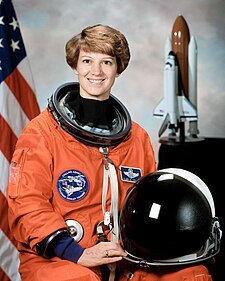Eileen Marie Collinsová
| Eileen Marie Collinsová | |
|---|---|
 Eileen Marie Collinsová | |
| Astronaut NASA | |
| Státní příslušnost | |
| Datum narození | 19. listopadu 1956 (67 let) |
| Místo narození | Elmira, New York, USA |
| Předchozí zaměstnání | testovací pilotka |
| Hodnost | plukovník |
| Čas ve vesmíru | 38 dní, 8 hodin a 10 minut |
| Kosmonautka od | 1990 |
| Mise | STS-63, STS-84, STS-93, STS-114 |
| Znaky misí | |
| Kosmonautka do | 2006 |
| Některá data mohou pocházet z datové položky. | |
Eileen Marie Collinsová (* 19. listopadu 1956, Elmira, New York, USA) je americká letecká instruktorka, zkušební pilotka, důstojnice a astronautka. Ve vesmíru byla čtyřikrát. Byla první pilotkou raketoplánu v programu Space Shuttle.
Život
Studium a zaměstnání
Absolvovala školu Elmira Free Academy (1974) a pak pokračovala ve studiu matematiky na Corning Community College. Školu ukončila v roce 1976 a pokračovala ve studiích na Syracuse University (1976–1978), Stanfordově univerzitě (ukončila 1986), USAF Institute of Technology (1985–1986), Webster University (ukončení 1989) a škole testovacích pilotů USAF Test Pilot School (1989–1990).
Jako pilotka působila v armádě v letech 1979 až 1990. V letech 1990 až 2006 byla členkou jednotky kosmonautů v NASA.
Vdala se, jejím manželem se stal James Pat Youngs.
Lety do vesmíru
Na oběžnou dráhu se v raketoplánech dostala čtyřikrát a strávila ve vesmíru 38 dní, 8 hodin a 10 minut. Pracovala na orbitálních stanicích MIR i ISS. Byla 321. člověkem ve vesmíru, 27. ženou.
- STS-63 Discovery (3. února 1995 – 11. února 1995), pilot
- STS-84 Atlantis (15. května 1997 – 24. května 1997), pilot
- STS-93 Columbia (23. červenec 1999 – 27. červenec 1999), velitelka
- STS-114 Discovery (26. července 2005 – 9. srpna 2005), velitelka
Odkazy
Externí odkazy
 Obrázky, zvuky či videa k tématu Eileen Collins na Wikimedia Commons
Obrázky, zvuky či videa k tématu Eileen Collins na Wikimedia Commons - Na webu Space
- Na webu MEK-Kosmo
Média použitá na této stránce

- The blue Shuttle rising above Earth's horizon includes the Columba constellation of seven stars, echoing the Columbia STS-107 patch and commemorating those seven crewmembers. The dominant element of the patch is the Earth, representing the unity and dedication of the many people whose efforts allow the Shuttle to return safely to flight. Against the nighttime Earth, the blue orbit represents the International Space Station, with the Shuttle crew spacewalk team named on the orbit. The red sun as the O in Noguchi signifies the contributions of the Japan Aerospace Exploration Agency to the mission and to the ISS program. The multi-colored Shuttle plume represents the spectrum of challenges for this mission, including Shuttle inspection and repair experiments, International Space Station resupply and repair, and testing of new safety procedures.
STS-63 Mission Insignia
The STS-84 emblem depicts the Space Shuttle Atlantis launching into Earth orbit to join the Russian Space Station Mir as part of Phase One (Shuttle-Mir) of the International Space Station program. The names of the eight astronauts who flew onboard Atlantis, including the two who changed their positions onboard Mir for a long duration flight, are shown along the border of the patch. The STS-84/Mir-23 team will transfer 7,000 pounds of experiments, Station hardware, food and clothing to and from Mir during the five-day period of docking. The Phase One program is represented by the rising Sun and by the Greek letter Phi followed by one star. This sixth Shuttle-Mir docking mission is symbolized by the six stars surrounding the word Mir in Cyrillic characters. Combined, the seven stars symbolize the current configuration of Mir, composed of six modules launched by the Russians and one module brought up by Atlantis on a previous docking flight.
Emblem of Nasa's STS-93 mission.
- The STS-93 mission patch, as designed by the five crew members. The STS-93 mission carried the Chandra X-Ray Observatory into low Earth orbit initiating its planned five-year astronomy mission. Chandra is the third of NASA’s great observatories, following the Hubble Space Telescope and the Compton Gamma Ray Observatory. Chandra provides scientists an order-of-magnitude improvement over current capabilities at X-Ray wavelengths. Observations of X-Ray emissions from energetic galaxies and clusters, as well as black holes, promise to greatly expand current understanding of the origin and evolution of our universe. The STS-93 patch depicts Chandra separating from the Space Shuttle Columbia after a successful deployment. A spiral galaxy is shown in the background as a possible target for Chandra observations. The two flags represent the international crew, consisting of astronauts from both the United States and France.
STS-93 Commander, Eileen M. Collins shown wearing an orange Launch and Entry Suit (LES) with helmet. Collins was the first woman to command a Space Shuttle mission.





